#lorawan gateway
Explore tagged Tumblr posts
Text
The Role of LoRaWAN Gateways in IoT: Connecting Devices Seamlessly

A LoRaWAN Gateway is a device that facilitates long-range wireless communication between IoT devices and centralized servers. It receives data from LoRaWAN devices using LoRa modulation and forwards it to network servers via a backhaul connection, typically using Ethernet, Wi-Fi, or cellular networks. Lansitec Outdoor LoRaWAN Gateway is an ideal product for IoT commercial deployment. Its modularity and customization options allow for flexibility when deploying a solution.
For More:
#iot#lansitec#lora#lorawan#technology#IoT Devices#LoRaWAN Devices#LoRaWAN Gateway#Outdoor LoRaWAN Gateway#Lansitec#Lansitec Outdoor LoRaWAN Gateway#wireless#IoT Network#LoRaWAN Network
0 notes
Text
Data Security and Precision Control: Precision Application of Smart Irrigation Using LoRa Technology and LoRaWAN Gateway
The application characteristics of LoRa modules in smart irrigation technology are mainly reflected in the following aspects:
Low Power Consumption: LoRa modules are characterized by extremely low power consumption, enabling devices to operate for extended periods on battery power. This reduces the hassle of frequent battery replacements and enhances the system's lifespan and reliability.
Anti-Interference Capability: LoRa technology has excellent anti-interference capabilities., ensuring stable communication quality even in environments with multiple radio signals.
Long-Distance Transmission: Utilizing low-frequency transmission, spread spectrum technology, and high-sensitivity receivers, LoRa modules can achieve wireless communication over distances ranging from several kilometers to over ten kilometers.
MESH Self-Organizing Network: LoRa modules can establish communication connections through self-organizing networks, eliminating the need for complex infrastructure and network wiring.
Precision Irrigation: LoRa modules offer stable and accurate data transmission, enabling real-time delivery of information such as soil moisture and weather conditions.
High Penetration: LoRa technology boasts strong signal penetration and stability, ensuring reliable signal transmission even in complex environments.
Multi-Node Support: LoRa modules support applications with multiple nodes. A single LoRa gateway can connect multiple sensor nodes, forming a complete network system for extensive, multi-point monitoring and management.
Data Security: LoRa modules provide high data security, employing encryption technology to protect data during transmission, preventing data theft or tampering, and ensuring the confidentiality and integrity of agricultural data.
Wide Coverage: LoRa technology can achieve wide coverage, typically ranging from several kilometers to over ten kilometers, without the repeaters.
Module Compatibility: LoRa modules are compatible with various types of sensors and control devices, offering a high level of system integration and facilitating seamless cooperation among different devices.

How the LoRa modules achieve precision irrigation in smart irrigation?
Remote Monitoring: Using LoRa modules, the irrigation system can achieve remote monitoring and control. Users can access real-time environmental data such as soil moisture and temperature from a distance and remotely control irrigation equipment, enabling precision irrigation.
Data Analysis: After the cloud platform receives sensor data, it analyzes and processes the information to promptly understand soil moisture conditions, providing a scientific basis for irrigation decisions.
Remote Control of Equipment: LoRa modules transmit commands to various irrigation nodes through long-distance, low-power wireless communication, controlling valve switches, irrigation times, and irrigation amounts.
Timed Irrigation: The irrigation schedule can be preset, and the LoRa module can be used to control the irrigation equipment to irrigate at the best time.
Feedback Mechanism: After irrigation is completed, the system re-monitors soil conditions and feeds the data back to the central control system.
Functions of the LoRaWAN Gateway LG1301-PF in Smart Irrigation Systems
Features of the LG1301-PF Gateway
LG1301-PF is the LoRaWAN gateway. It can work with any LoRaWAN node which comply Standard LoRaWAN protocol V1.0.
The gateway use linux platform as host.It mainly consists of concentrator ,GPS module ,WIFI and Ethernet. The GPS module send NMEA frames containing time and geographical coordinates data to the host. The GPS module also output one pulse to the sx1301 per second.
The gateway receives the RF data from nodes and sends it to the server. It also receive data from the server and transmit to the nodes. The gateway connects to the server via Ethernet or WiFi.
Support for LoRaWAN Protocol: Adapts to the LoRaWAN protocol, enabling the device to communicate with standard LoRaWAN networks for remote data transmission and management.
UART Interface: Provides a UART interface for convenient data exchange and integration with other devices or sensors.
AES128 Encryption: Uses the AES128 encryption algorithm to ensure the security and privacy of data transmission.
8-Channel Simultaneous Communication: Supports up to 8 channels of communication simultaneously
Configurable Parameters: Users can flexibly configure various parameters according to specific application needs.
Global Positioning System Support: GPS functionality enables precise positioning and tracking of the device.
Remote Transmission: Supports remote data transmission, allowing real-time data transfer and management between the device and the cloud via an internet connection.
Frequency Band Support: Covers multiple frequency bands (such as EU433M, EU868M, KR920M, AS923M, CN780M, CN470M, US915M, AS915M, etc.).
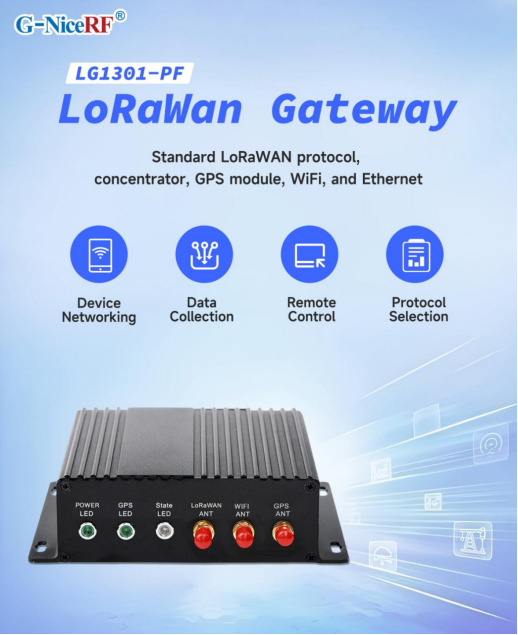
By using NiceRF LoRa gateway devices, sensor equipment in the irrigation field (such as temperature sensors, humidity sensors, light sensors, CO2 sensors, etc.) can be connected in real-time. These sensors collect data in real-time and periodically upload it to the cloud platform or local host computer via LoRa modules. This setup enables remote monitoring, fault alarms, equipment management, and provides scientific and reliable data support for adjusting irrigation strategies.
Data Monitoring Function: The sensor equipment monitors data such as air temperature, air humidity, CO2 levels, light intensity, soil moisture, and soil temperature. This data is transmitted through the LoRa gateway to the cloud platform, allowing users to analyze and process the information conveniently.
Remote Control and Adjustment: The LoRa gateway can connect to irrigation equipment, enabling remote control of the irrigation system. By sending commands from the cloud platform to the LoRa gateway, users can adjust irrigation equipment, such as remotely starting or stopping the equipment or adjusting irrigation parameters. This allows for intelligent irrigation based on feedback from soil moisture sensors, providing precise water management, reducing waste, and improving irrigation efficiency.
Anomaly Alarms and Warnings: The LoRa gateway can monitor abnormal conditions in the farmland environment and send alarm messages to users through the cloud platform. For instance, if soil moisture levels are too low or too high, the LoRa gateway can promptly issue an alert, reminding farmers to take appropriate irrigation measures.
Energy Efficiency Optimization: The gateway is designed with low power consumption features. By optimizing energy management and data transmission frequency, it effectively extends the operating time of the equipment, reduces energy costs, and enhances system sustainability.
For details, please click:https://www.nicerf.com/products/ Or click:https://nicerf.en.alibaba.com/productlist.html?spm=a2700.shop_index.88.4.1fec2b006JKUsd For consultation, please contact NiceRF (Email: [email protected]).
0 notes
Text
GPIOs do LoRaMesh da Radioenge: Portas digitais
Aprenda como usar as GPIOs do módulo LoRaMesh da Radioenge
As GPIOs do LoRaMesh da Radioenge possibilita que possamos fazer aplicações de automação com um uso reduzido de hardware, dedicando apenas ao circuito de chaveamento (se necessário) e de alimentação. No total temos no LoRaMesh 8 GPIOs sendo todas configuráveis como entrada ou saída digital e duas como leitura analógica. Porém neste post vamos apenas abordar as portas digitais. Por qual motivo…
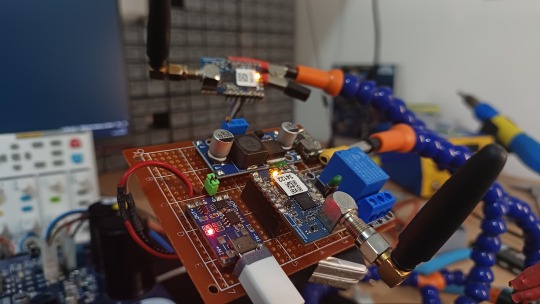
View On WordPress
#lora mesh arduino#lora mesh chat#lora mesh device#lora mesh library#lora mesh module#lora mesh network#lora mesh network raspberry pi#lora mesh protocol#lora mesh radio#lora mesh range#lora vs lorawan#loramesh#lorawan#lorawan devices#lorawan gateway#lorawan network#mesh lora
0 notes
Text
What is the difference between the LoRaWAN wireless module and LoRa gateway wireless transmission technology?
Many individuals find it challenging to differentiate between the LoRaWAN wireless module and LoRa gateway wireless transmission technology, as well as their applications within the realm of IoT.
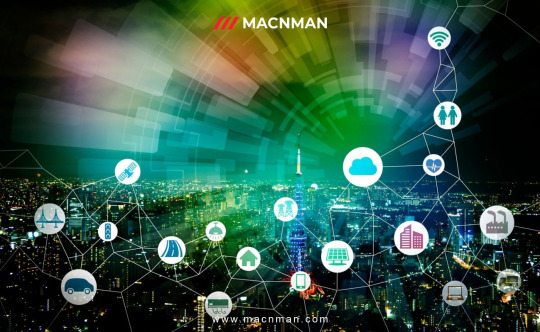
LoRaWAN specifically pertains to the networking protocol found within the MAC (Media Access Control) layer. In contrast, LoRa serves as a protocol within the physical layer. Although current LoRaWAN networking implementations utilize LoRa as the physical layer, it's worth noting that the LoRaWAN protocol also allows for the use of GFSK (Gaussian Frequency-Shift Keying) as the physical layer in specific frequency bands. From a network layering perspective, LoRaWAN can adopt various physical layer protocols, just as LoRa can serve as the physical layer for other networking technologies.
LoRa, as a technology, falls under the category of LPWAN (Low-Power Wide-Area Network) communication technologies. It represents an ultra-long-distance wireless transmission method based on spread spectrum technology, pioneered and promoted by Semtech in the United States. This approach revolutionizes the previous trade-off between transmission distance and power consumption, offering users a straightforward system capable of achieving extended range, prolonged battery life, and increased capacity. Consequently, it expands the capabilities of sensor networks. Currently, LoRa predominantly operates within free frequency bands globally, including 433/868/915MHz, among others.
On the other hand, LoRaWAN wireless communication stands as an open standard defining the communication protocol for LPWAN technology based on LoRa chips. LoRaWAN defines the Media Access Control (MAC) layer at the data link level and is overseen by the LoRa Alliance. It's crucial to distinguish between LoRa and LoRaWAN because companies like Link Labs utilize a proprietary MAC layer in conjunction with LoRa chips to create more advanced hybrid designs, such as Link Labs' Symphony Link.
LoRaWAN typically employs a star or star-to-star topology, which is generally considered superior to mesh networks due to advantages such as conserving battery power and extending communication range. In a star topology, messages are relayed to a central server through gateways, and each end node can transmit data to multiple gateways. These gateways then forward the data to the web server, where tasks like redundancy detection, security checks, and message scheduling are executed.
In summary, LoRa encompasses solely the link layer protocol, making it suitable for point-to-point (P2P) communication between nodes. In contrast, LoRaWAN includes the network layer, allowing data to be sent to any base station connected to a cloud platform. By connecting the appropriate antenna to its socket, the LoRaWAN module can operate at different frequencies, offering versatility in its applications.
0 notes
Text
Estación Meteorológica IoT Mexico
🌿 Exellios® Estación Meteorológica IoT: Telemetría Inalámbrica de Alto Desempeño Monitoreo Ambiental Preciso con Sensores WTS y Tecnología LoRaWAN® La Exellios® Estación Meteorológica IoT es una solución de monitoreo ambiental todo en uno, diseñada para operar de forma continua y confiable en diversos entornos agrícolas e industriales. Equipada con sensores WTS Wireless Telemetry Systems,…
#Agricultura Inteligente#Agricultura inteligente con IoT#Ahorro de recursos agrícolas#Batería recargable para IoT#Cobertura LoRaWAN de largo alcance#Conectividad LoRaWAN#Configuración NFC de dispositivos IoT#Datos ambientales en tiempo real#Datos ambientales remotos#Datos atmosféricos precisos#Dispositivos de monitoreo ambiental industrial#Estación meteorológica autónoma#Estación meteorológica con energía solar#Estación meteorológica IoT#Estación meteorológica para agricultura#Estación meteorológica profesional#Estación meteorológica robusta IP67#Estación meteorológica todo en uno#Exellios#Gateway LoRaWAN para estaciones IoT#Humedad del suelo sensor#Mejorar rendimiento agrícola#Monitoreo Agrícola#Monitoreo agrícola inalámbrico#Monitoreo ambiental automatizado#Monitoreo Ambiental LoRaWAN#Monitoreo ambiental remoto#Monitorización cultivos#Panel solar estación meteorológica#Panel solar para estaciones IoT
0 notes
Text
Top Hart to Modbus Gateway Suppliers for Seamless Integration
Looking for reliable Hart to Modbus Gateway suppliers? We offer high-performance solutions for industrial automation and process control systems. Enhance your data communication with our plug-and-play gateways that support real-time monitoring and efficient system integration.

0 notes
Text
Water Metering: Competitive advantage for scaled IoT
#1-Wire#Bluetooth#Councils#gateway#LoRaWAN#Modbus#Municipalities#NB-IoT#Network#Predictive Analytics#Real-time#Scale#Supply#Utilities#Water Meter
0 notes
Text
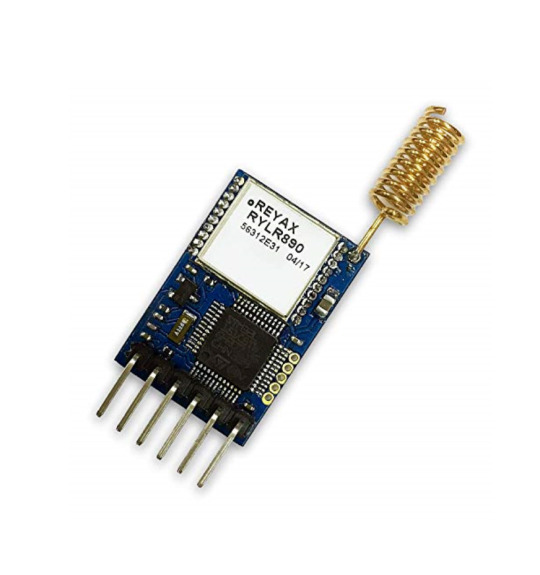
LoRa communication Module
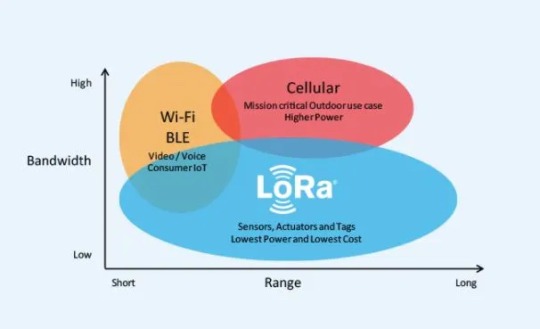
youtube
:
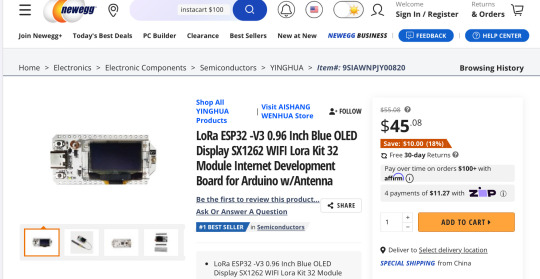
. https://www.newegg.com/p/2A3-00UG-000J9
youtube
.
.
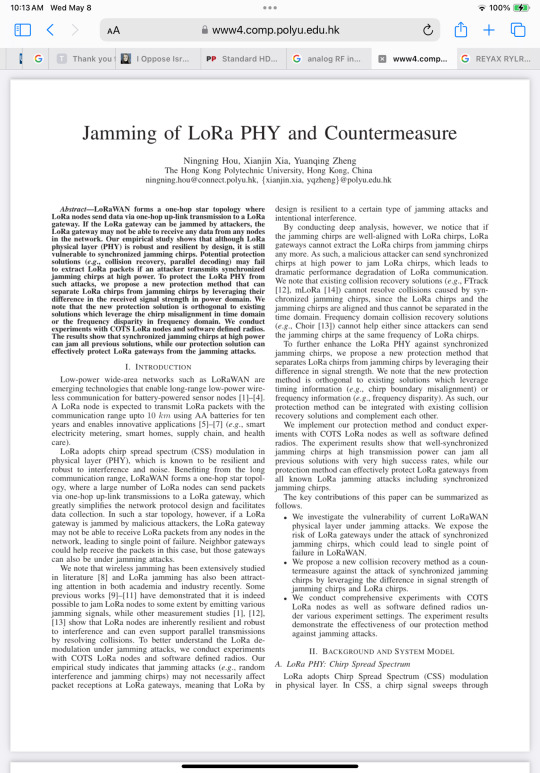
. https://www4.comp.polyu.edu.hk/~csyqzheng/papers/LoRaJamming-INFOCOM21.pdf
2 notes
·
View notes
Text
IoT Remote Monitoring: Revolutionizing Industries with Real-Time Data
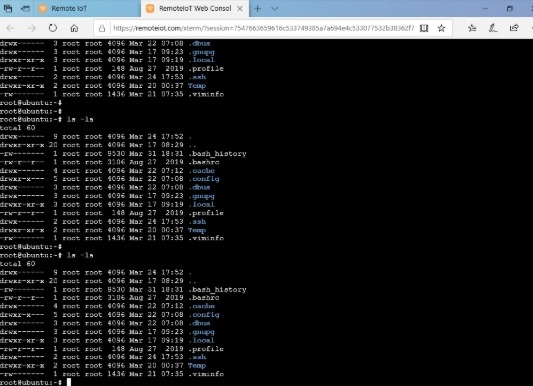
The rapid advancement of IoT remote monitoring has transformed how industries operate, enabling real-time data collection, analysis, and decision-making. By leveraging connected devices, sensors, and cloud computing, businesses can monitor assets, optimize processes, and reduce downtime. This article explores the impact of IoT remote monitoring across various sectors, its key benefits, challenges, and future trends.
What Is IoT Remote Monitoring?
IoT remote monitoring refers to the use of Internet of Things (IoT) devices to track and manage equipment, environments, or processes from a distance. These systems collect data through sensors, transmit it via wireless networks, and provide actionable insights through centralized platforms.
Key Components of IoT Remote Monitoring Systems
Sensors & Devices – Measure parameters like temperature, pressure, humidity, or motion.
Connectivity – Wi-Fi, cellular, LoRaWAN, or Bluetooth transmit data to the cloud.
Cloud Platform – Stores and processes data for analysis.
User Interface – Dashboards and alerts for real-time monitoring.
Applications of IoT Remote Monitoring
1. Industrial Equipment Monitoring
Manufacturers use IoT remote monitoring to track machinery health, predict failures, and schedule maintenance. Vibration sensors, thermal imaging, and performance analytics help prevent costly breakdowns.
2. Healthcare & Patient Monitoring
Wearable devices and medical sensors enable remote patient monitoring, allowing doctors to track vital signs like heart rate, blood pressure, and glucose levels in real time.
3. Smart Agriculture
Farmers deploy soil moisture sensors, weather stations, and drone-based imaging to optimize irrigation, detect pests, and improve crop yields.
4. Energy Management
Utilities and businesses use IoT remote monitoring to track energy consumption, detect leaks, and optimize power distribution in smart grids.
5. Fleet & Asset Tracking
Logistics companies monitor vehicle location, fuel consumption, and driver behavior to enhance efficiency and reduce operational costs.
Benefits of IoT Remote Monitoring
1. Real-Time Visibility & Alerts
Continuous data streaming allows immediate detection of anomalies, triggering alerts for quick resolution.
2. Predictive Maintenance
By analyzing historical and real-time data, businesses can predict equipment failures before they occur, reducing downtime.
3. Cost Savings
Automated monitoring reduces manual inspections, labor costs, and energy waste.
4. Improved Safety
In hazardous environments, IoT remote monitoring minimizes human intervention, enhancing workplace safety.
5. Scalability & Flexibility
Cloud-based systems allow easy expansion, supporting additional devices and applications as needed.
Challenges in Implementing IoT Remote Monitoring
Despite its advantages, IoT remote monitoring faces several challenges:
1. Data Security & Privacy Risks
Connected devices are vulnerable to cyberattacks, requiring robust encryption and authentication measures.
2. Connectivity Issues
Remote locations may suffer from poor network coverage, affecting data transmission reliability.
3. High Initial Costs
Deploying sensors, gateways, and cloud infrastructure can be expensive for small businesses.
4. Data Overload
Managing large volumes of sensor data requires efficient storage and analytics solutions.
Future Trends in IoT Remote Monitoring
1. AI & Machine Learning Integration
Advanced analytics will enable smarter anomaly detection and automated decision-making.
2. 5G & Edge Computing
Faster networks and localized data processing will reduce latency and enhance real-time monitoring.
3. Blockchain for Security
Decentralized ledgers can improve data integrity and prevent tampering in IoT remote monitoring systems.
4. Expansion in Smart Cities
Traffic management, waste monitoring, and public safety will increasingly rely on IoT-driven solutions.
1 note
·
View note
Text
IoT Communication Protocol Market Enabling Next-Gen Industrial IoT (IIoT) Innovations
TheIoT Communication Protocol Market Size was valued at USD 16.95 Billion in 2023 and is expected to reach USD 23.94 Billion by 2032 and grow at a CAGR of 4.2% over the forecast period 2024-2032.
IoT Communication Protocol Market is witnessing notable growth as the demand for seamless device connectivity accelerates across industries. With businesses increasingly adopting smart devices, machine-to-machine communication has become essential for data sharing, automation, and efficiency. Protocols such as MQTT, CoAP, and Zigbee are playing a vital role in enabling reliable, low-power, and scalable communication.
U.S. Leads in Advancing IoT Infrastructure Through Protocol Innovation
IoT Communication Protocol Market is evolving with the integration of edge computing, AI, and 5G, which are reshaping how devices interact in real time. As industries like healthcare, automotive, and manufacturing pivot to intelligent operations, the need for secure, flexible, and interoperable communication standards continues to rise.
Get Sample Copy of This Report: https://www.snsinsider.com/sample-request/6554
Market Keyplayers:
Huawei Technologies (OceanConnect IoT Platform, LiteOS)
Arm Holdings (Mbed OS, Cortex‑M33 Processor)
Texas Instruments (SimpleLink CC3220 Wi‑Fi MCU, SimpleLink CC2652 Multiprotocol Wireless MCU)
Intel (XMM 7115 NB‑IoT Modem, XMM 7315 LTE‑M/NB‑IoT Modem)
Cisco Systems (Catalyst IR1101 Rugged Router, IoT Control Center)
NXP Semiconductors (LPC55S6x Cortex‑M33 MCU, EdgeLock SE050 Secure Element)
STMicroelectronics (STM32WL5x LoRaWAN Wireless MCU, SPIRIT1 Sub‑GHz Transceiver)
Thales (Cinterion TX62 LTE‑M/NB‑IoT Module, Cinterion ENS22 NB‑IoT Module)
Zebra Technologies (Savanna IoT Platform, SmartLens for Retail Asset Visibility)
Wind River (Helix Virtualization Platform, Helix Device Cloud)
Ericsson (IoT Accelerator, Connected Vehicle Cloud)
Qualcomm (IoT Services Suite, AllJoyn Framework)
Samsung Electronics (ARTIK Secure IoT Modules, SmartThings Cloud)
IBM (Watson IoT Platform, Watson IoT Message Gateway)
Market Analysis
The IoT Communication Protocol Market is driven by the explosion of connected devices and the need for efficient, low-latency data transmission. Communication protocols serve as the foundation for interoperability among heterogeneous IoT devices, ensuring real-time synchronization and security. The U.S. is leading with early adoption and robust R&D, while Europe contributes significantly with regulatory support and smart city deployments.
Market Trends
Increasing adoption of LPWAN protocols like LoRaWAN and NB-IoT
Rise of MQTT and CoAP in industrial and home automation applications
Shift towards IPv6 for improved scalability and addressability
Integration of 5G enhancing speed and reliability in protocol performance
Growing emphasis on cybersecurity and encrypted data exchange
Development of hybrid protocols to support multi-layered IoT architectures
Market Scope
The market is expanding beyond traditional device communication and into intelligent ecosystems. Protocols are now expected to support not only connectivity but also data prioritization, edge computing compatibility, and energy efficiency.
Real-time communication for industrial automation
Protocols optimized for ultra-low power IoT devices
Interoperability across cloud, edge, and device layers
Smart city applications requiring scalable communication
Healthcare devices demanding secure and reliable data transfer
Automotive systems relying on low-latency connections
Forecast Outlook
The IoT Communication Protocol Market is set to grow at a rapid pace as device ecosystems multiply and application complexity deepens. Success will depend on protocol adaptability, security, and standardization efforts that support global deployment. With North America at the forefront and Europe driving policy-aligned innovation, the market is primed for a shift from fragmented systems to harmonized connectivity solutions.
Access Complete Report: https://www.snsinsider.com/reports/iot-communication-protocol-market-6554
Conclusion
As industries become increasingly connected, the IoT Communication Protocol Market plays a crucial role in shaping the future of smart operations. From San Francisco’s automated logistics to Berlin’s connected healthcare systems, the demand for agile, secure, and scalable communication protocols is setting new standards. Forward-thinking enterprises that prioritize protocol innovation will lead the charge in building resilient and intelligent digital ecosystems.
About Us:
SNS Insider is one of the leading market research and consulting agencies that dominates the market research industry globally. Our company's aim is to give clients the knowledge they require in order to function in changing circumstances. In order to give you current, accurate market data, consumer insights, and opinions so that you can make decisions with confidence, we employ a variety of techniques, including surveys, video talks, and focus groups around the world.
Related Reports:
U.S.A sees rising adoption of IoT middleware as industries push for smarter automation solutions
U.S.A. accelerates financial innovation through Robotic Process Automation in BFSI operations
Contact Us:
Jagney Dave - Vice President of Client Engagement
Phone: +1-315 636 4242 (US) | +44- 20 3290 5010 (UK)
Mail us: [email protected]
#IoT Communication Protocol Market#IoT Communication Protocol Market Scope#IoT Communication Protocol Market Share#IoT Communication Protocol Market Growth
0 notes
Text
8 Channel Indoor LoRaWAN Gateway | SX1302 LoRa Gateway

The Lansitec Indoor LoRaWAN Gateway is designed for easy indoor deployment, featuring built-in Ethernet, optional LTE uplink, and 2.4 GHz Wi-Fi for quick AP-based configuration. Powered by Semtechu2019s SX1302 chipset and supporting LoRaWAN V1.0.3, this gateway offers a scalable solution for small to medium-sized IoT applications. With OpenWRT software, built-in network server, and PoE compatibility, it simplifies installation and reduces both hardware and operational costs.
For More:
#commercial LoRaWAN Gateway#indoor Lorawan gateway#8 channel indoor lorawan gateway#Sensor integration#SX1302 LoRa Gateway#iot#lansitec#lora#technology#lorawan#bluetooth#wireless#gps
0 notes
Text
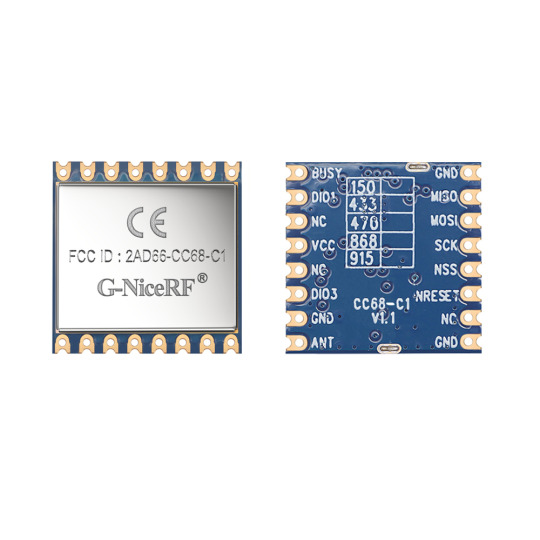
RF Transmitter and Receiver: Key Components in Wireless Communication
RF (Radio Frequency) transmitters and receivers are fundamental components in modern wireless communication systems. These components play a pivotal role in enabling various wireless technologies, from mobile phones to Wi-Fi routers, to operate seamlessly. In this article, we will explore the significance of RF transmitter and receiver in wireless communication and delve into their essential functions and applications.
RF Transmitter: Sending Signals Wirelessly
An RF transmitter is a crucial element in any wireless communication system. It is responsible for converting electrical signals into radio waves that can travel through the air and be received by compatible devices. RF transmitters are found in a wide range of applications, including radio broadcasting, remote control systems, and data transmission.
One of the key features of an RF transmitter is its ability to modulate the carrier signal with the information to be transmitted. This modulation process allows the transmitter to encode data, voice, or other forms of information onto the radio waves. The modulated signal is then amplified and broadcasted through an antenna.
In modern wireless technologies, such as Bluetooth and Wi-Fi, RF transmitters are the driving force behind the wireless connectivity that allows devices to communicate with each other over short or long distances.
RF Receiver: Capturing and Decoding Signals
On the receiving end, the RF receiver is responsible for capturing the transmitted radio waves, demodulating them, and converting them back into electrical signals that can be processed by electronic devices. RF receivers are integral components in devices like car radios, GPS systems, and satellite television receivers.
The receiver's demodulation process is crucial because it extracts the original information from the modulated carrier signal. This process allows the receiver to recover the transmitted data, audio, or video signal accurately. In essence, the RF receiver acts as the gateway for converting radio waves into usable information.
Applications of RF Transmitters and Receivers:
Wireless Communication: RF transmitters and receiver is the backbone of wireless communication system, enabling devices to transmit voice, data, and multimedia content over the airwaves. They are vital for mobile phones, two-way radios, and wireless Internet connections.
Remote Control Systems: Many remote control devices, including TV remotes, garage door openers, and toy controllers, rely on RF transmitters and receivers to send and receive signals.
Telemetry and Data Acquisition: In industries like agriculture and environmental monitoring, RF technology is used to collect data wirelessly from remote sensors and devices.
Security Systems: Wireless security systems, such as home alarms and surveillance cameras, use RF transmitter and receiver for communication between sensors and control panels.
Conclusion:
RF transmitters and receivers are the unsung heroes of the wireless world, making it possible for us to communicate, control devices remotely, and access information seamlessly. As technology continues to advance, these essential components will continue to evolve and play a pivotal role in our increasingly connected world. Whether it's sending a text message, streaming a video, or unlocking your car with a remote, RF transmitter and receiver is at the heart of it all, making our lives more convenient and interconnected.
For details, please click:
Or click:https://www.alibaba.com/product-detail/G-NiceRF-CC68-C1-160mW-433MHz_1600914212665.html?spm=a2747.manage.0.0.78e071d2L4s02Q
For consultation, please contact NiceRF (Email: [email protected])
0 notes
Text
Leitura analógica do LoRaMesh da Radioenge
Aprenda como usar a leitura analógica com o módulo LoRaMesh da Radioenge
A leitura analógica com o LoRaMesh possibilita com que possamos fazer um amplo sistema de sensoriamento remoto sem precisar necessariamente de microcontrolador adicional na parte do slave. Por qual motivo usar a leitura analógica do LoRaMesh da Radioenge? Uma leitura digital em muito dos casos já é mais que o suficiente para saber se algo está ou não funcionando, mas a leitura analógica do…
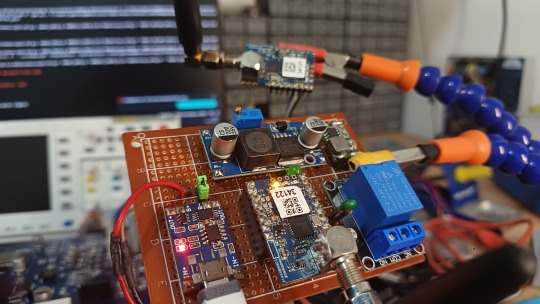
View On WordPress
#lora mesh arduino#lora mesh chat#lora mesh device#lora mesh library#lora mesh module#lora mesh network#lora mesh network raspberry pi#lora mesh protocol#lora mesh radio#lora mesh range#lora vs lorawan#loramesh#lorawan#lorawan devices#lorawan gateway#lorawan network#mesh lora
0 notes
Text
How do you handle water meter reading using Lora (Raspberry Pi, Arduino, Lorawan, IoT)?
Install a LoRaWAN Gateway: Begin by setting up a LoRaWAN gateway. This gateway acts as a receiver for data transmitted by LoRaWAN devices and forwards it to the network server. It connects to the internet and communicates with LoRaWAN devices within its coverage area.
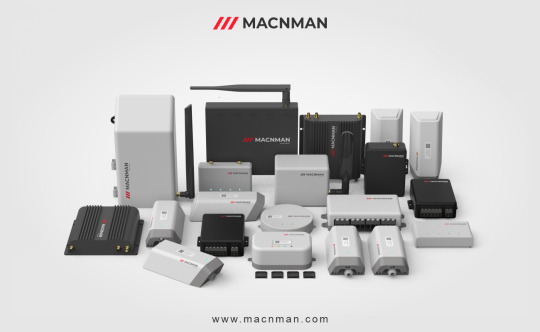
Attach LoRaWAN Modules to Water Meters: Next, equip your water meters with LoRaWAN modules or sensors. These modules are responsible for gathering important data, such as water consumption readings, from the meters.
Develop Firmware/Software: Program your Raspberry Pi or Arduino device to collect data from the water meters through the LoRaWAN modules. This programming may involve utilizing the LoRaWAN library or SDK provided by the module manufacturer.
Set Up a LoRaWAN Network Server: Install and configure a LoRaWAN network server. This server will receive and handle data from the water meters. Its functions include managing device registrations, routing messages, and storing data.
Ensure Secure Data Transmission and Encryption: Utilize LoRaWAN protocols to securely transmit the water meter readings from your Raspberry Pi or Arduino to the network server. LoRaWAN uses AES encryption to safeguard data privacy during transmission.
Data Processing and Storage: Once the network server receives the data, process it as needed. Extract the relevant water consumption readings and conduct any necessary calculations or validations. Store the data in a database or another suitable storage system.
Integration and Visualization: To make sense of the data, integrate it with your chosen IoT platform or application. This integration allows for further analysis and visualization. Consider creating a web-based dashboard or a mobile app to present the water consumption data in a user-friendly and informative manner.
It's important to keep in mind that the specific steps and details of implementation may vary based on the hardware and software components you select and any unique requirements associated with your water meter system. Adapt the above steps as necessary to align with your specific setup and development environment.
0 notes
Text
Robouter Cerebro Robot
Robouter Cerebro Robot : El Cerebro de Alto Rendimiento para la Revolución de la Robótica Industrial En la era de la Industria 4.0, la automatización industrial y la eficiencia operativa son fundamentales para la competitividad. Exellios® presenta Robouter, una innovadora solución de alto rendimiento diseñada para potenciar Vehículos Guiados Automatizados (AGV) y Robots Móviles Autónomos (AMR).…
#Almacén automatizado#automatización industrial#Cómo mejorar la eficiencia con robots móviles autónomos#Codificación de video de alta resolución#Comprar computadora integrada AGV#Computadora de placa única AGV#Computadora de placa única AMR con procesamiento de video 8K#Computadora de placa única para robots móviles autónomos#Computadora integrada AGV#Conectividad industrial#Exellios Robouter#Fábrica inteligente#Gateway LoRaWAN 5G#Gateway LoRaWAN 5G para aplicaciones industriales#Gateway LoRaWAN 5G para entornos industriales#Industria 4.0#Inteligencia artificial (IA) robótica#IoT Industrial#Logística automatizada#Mejor computadora de placa única para AMR#Navegación autónoma#Placa de computadora integrada AGV con IA#Procesador octa-core para robótica industrial#Procesamiento de video 8K#Robótica industrial#Robots móviles autónomos (AMR)#Robouter#Sistema de control de alto rendimiento para AGV#Sistemas de navegación autónoma para AGV de almacén#Sistemas integrados industriales
0 notes